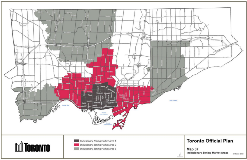City of Toronto Introduces Inclusionary Zoning Framework
The City of Toronto approved its new inclusionary zoning framework on November 9, 2021. Council adopted the official plan amendment (“OPA”) and passed the zoning by-law amendment (“ZBA”) that will permit the City to require a percentage of all new development within delineated Protected Major Transit Station Areas (“PMTSA”) to be affordable housing. The City also adopted amendments to certain definitions relating to affordable housing in its Official Plan.
Inclusionary zoning is a tool that permits municipalities to require a certain portion of new development to be made affordable to people with low and moderate incomes. We provided an update on the City’s proposed inclusionary zoning framework here, as it was first introduced in September 2020.
In Toronto, a phased-in requirement of 5-10% of the gross floor area (“GFA”) of new development will be required to be provided as affordable housing starting on September 18, 2022, which requirement incrementally increases to 8-22% by 2030.
Where does IZ apply?
The City’s inclusionary zoning framework applies to developments within delineated PMTSAs that are located in an Inclusionary Zoning Market Area.
(a) PMTSAs
The Planning Act limits the application of inclusionary zoning to areas surrounding certain transit station areas known as PMTSAs (or where a development permit system is in place, which is not the case in Toronto).
A Major Transit Station Area (“MTSA”) is defined in the Growth Plan for the Greater Golden Horseshoe, 2019 as an area within a radius of approximately 500-800 metres of a transit station, representing a 10-minute walk. A PMTSA is a subset of MTSA that will have a specific policy framework related to minimum density and other metrics.
There are currently two adopted but not yet approved and 23 proposed PMTSAs in Toronto. The 16 proposed PMTSAs are within the Downtown and it is anticipated that they will be brought forward to Council for adoption later this year or early 2022. The City has indicated that it intends to bring forward OPAs for the remainder of the PMTSAs where inclusionary zoning would apply by July 2022, the deadline by which it is required to do so by the Province.
PMTSAs are subject to approval by the Minister and cannot be appealed.
(b) Inclusionary Zoning Market Areas
The City has established three Inclusionary Zoning Market Areas which are shown in new Official Plan Map 37. These are areas in the City that have experienced the greatest amount of new housing supply, significant price escalation and growth in rental prices, and where the City has determined that its inclusionary zoning requirements can be imposed without jeopardizing development viability. The three Market Areas are subject to different affordable housing requirements, which reflect each Area’s ability to absorb the new requirements based on existing market conditions.
(c) Areas not included
Areas that have not been included in the Market Areas are areas where the City has determined that significant new development is not occurring and prices and price growth have not been strong compared to the City as a whole. However, the City has indicated that its inclusionary zoning regime could apply in these areas in the future if market conditions change. Council directed staff to conduct additional market analysis for a number of specific areas, including Little Jamaica, the Sheppard Subway Corridor, Mount Dennis, Weston Road and Lawrence Avenue West, North York Centre and the Marlee Ville corridor to determine if these areas should be added to the Inclusionary Zoning Map (Map 37) and therefore form part of one of the City’s Inclusionary Zoning Market Areas. Staff have been directed to report back to City Council no later than June 2022.
Substantive requirements
(a) Percentage of GFA required to be provided as affordable housing
The percentage of required affordable housing is based on:
- The Inclusionary Zoning Market Area within which the site is located;
- Tenure of the proposed development (condominium development vs. purpose built rental); and
- Tenure of the affordable units (affordable rental housing vs. affordable ownership housing).
The rate of affordable housing is determined based on a percentage of the total newGFA in a development. These requirements are in addition to any applicable residential rental housing replacement obligations under section 111 of the City of Toronto Act, 2006. However, the GFA provided as part of rental replacement is not included in the calculation of the required affordable housing under the inclusionary zoning regime.
The percentage of affordable housing will be phased in, with a greater percentage of GFA to be required each year between 2022 and 2030.
(i) Condominium developments
The chart below sets out the phase-in schedule for condominium developments securing affordable rental or affordable ownership:
(ii) Purpose built rental
There is no minimum affordable housing required prior to January 1, 2026 for purpose built rental developments, but after that date 5% of GFA will be required to be affordable rental units in new developments within Inclusionary Zoning Market Area 1 and 3% within Inclusionary Zoning Market Area 2. There is no minimum affordable housing requirement for purpose built rental developments in Inclusionary Zoning Market Area 3.
(b) Tenure and mix
Affordable housing is to be secured for a period of at least 99 years, based on the date of first residential occupation of the unit.
The unit mix of affordable housing must reflect the market component of the development in order to achieve a broader mix of unit types and sizes to create more affordable housing suitable for families.
(c) Off-site units
While the provincial inclusionary zoning policy framework allows for the provision of affordable units off-site but close to the new development, the City’s framework is more restrictive.
The OPA provides that the City has the discretion to permit some or all of the affordable housing to be provided off-site where it determines that:
- the off-site units provide for an improved housing outcome;
- the off-site units are ready for occupancy at a time commensurate with the proposed development; and
- the off-site units are located in proximity to the proposed development, meaning that they are located within the same market area category.
(d) Exceptions
The City’s inclusionary zoning regime does not apply to:
- New developments with less than 100 dwelling units and less than 8,000 square metres of residential GFA.
- Additions or changes of use to existing buildings, where there are less than 100 new dwelling units or less than 8,000 square metres of new residential GFA.
- Non-profit housing where the non-profit housing provider has:
- 100% ownership interest, or
- at least 51% ownership interest and at least 51% of the dwelling units will be affordable housing units.
- Student residences.
- Retirement homes, nursing homes and residential care homes.
(e) Market impact review after one year
Staff have been directed to review the market impacts of the inclusionary zoning regime one year after implementation in order to determine if any amendments are required such as: the need for incentives, changes to the phase-in/set aside rates, the minimum development size threshold and any other changes to ensure market stability and production of affordable units.
Transition
Developments will be exempt from the inclusionary zoning regime where:
- In the case of a zoning by-law amendment and site plan applications:
- complete applications for a zoning by-law amendment and site plan approval are filed on or before the later of September 18, 2022 or notice of approval of a PMTSA by the Minister;
- a zoning by-law amendment comes into force:
- before the passing of the City’s Community Benefits Charge By-law and
- a Section 37 Agreement has been executed on or prior to the later of September 18, 2022 or approval of the PMTSA by the Minister; or
- a complete application for site plan approval is filed on or before the later of September 18, 2022 or notice of approval of a PMTSA by the Minister.
- A complete application for a minor variance is filed on or before the later of September 18, 2022 or notice of approval of a PMTSA by the Minister.
- A complete application for a building permit is filed on or before the later of September 18, 2022 or notice of approval of a PMTSA by the Minister.
No right to appeal
There is no right to appeal the City’s OPA and ZBA implementing its inclusionary zoning regime, since it is subject to Ministerial approval. Only the Minister of Municipal Affairs and Housing may appeal Inclusionary Zoning Official Plan policies and implementing zoning to the Ontario Land Tribunal.
New definition of “affordability”
The City also adopted an OPA that amends the following definitions for affordable housing in the Official Plan by aligning definitions of affordability with incomes:
- affordable rental housing and affordable rents (affordable rental housing);
- mid-range rents, including adding two new mid-range rent tiers; and
- affordable ownership housing.
Previously, affordable housing had been based on market rents/prices. The new definitions in the Official Plan mirror those in the City’s inclusionary zoning framework. This change will result in a reduction in affordable rents for studio units, one-bedroom units and three-bedroom units compared to affordable rent for each unit type under the previous definition, and a reduction of affordable ownership prices for all unit types.
These new definitions do not apply to developments with complete applications filed by November 10, 2021 or development projects with an affordable housing component that have been approved in principle by Council or the Ontario Land Tribunal by November 10, 2021.







